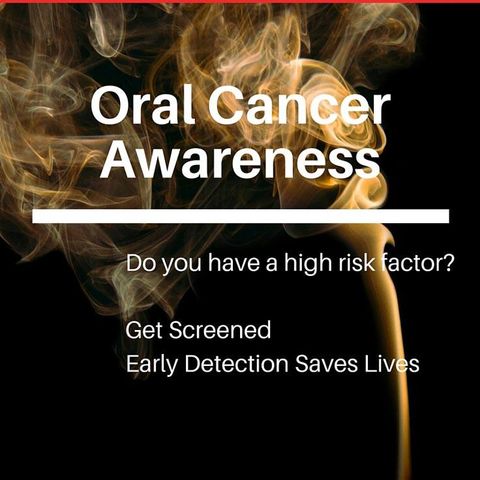
Oral cancer is among the deadlist, with a death rate higher than many types of other cancers. About 30,000 new people will be diagnosed with oral cancer this year. Sadly, among them, only about half will survive more than five years. This is due to the fact that many cases of oral cancer are not diagnosed in the early stages when it is the most treatable.
Signs and symptoms of oral cancer include sores or irritations that don’t go away, red or white patches, pain, tenderness or numbness in mouth or lips, difficulty chewing, swallowing or moving your tongue or jaw, changes in the way your teeth fit together when you close your mouth, and lumps or thickened rough spots. Some people have a nagging sore throat or feel like they have something caught in their throat. At times hoarseness or changes in their voice are a sign that something isn’t right. These symptoms may very well be harmless at times, but they can also be the beginnings of oral cancer. It’s so important not to ignore these signs and symptoms in order to avoid the possibility of oral cancer spreading and leading to more serious health issues. Early detection is truly the key in keeping you or someone you love from becoming one of those people whose lives are claimed this year.
Dr. Joy Lunan plays a critical role in the detection of oral cancer. At each of your dental cleanings she will visually exam mouth tissues including your lips, cheek linings, gums, tongue, the floor and roof of your mouth, and the back of your mouth and throat. She will also feel along your jaw and neck for any swollen lymph nodes or hardened masses and review your xrays for any changes. She also uses a velscope yearly to scan the tissues for any signs that things are abnormal.
You may be wondering who gets oral cancer and if you are at risk. Not surprising, oral cancer, more often than not, occurs in people who use tobacco products. When tobacco use is combined with alcohol use oral cancer risks rise about 15% more than non-tobacco and non-alcohol patients. Men are twice more likely to get oral cancer than women. Oral cancer is more likely to strike after the age of 40. Please remember, even if you don’t fall into any of these categories, you cannot ignore the symptoms. About 25% of oral cancer patients are ones that do not use any tobacco products.
HPV, the human papilloma virus, is sexually transmitted, but has been linked to throat cancers. HPV-positive head and neck cancer cases are related to the rise in oral cancer in non-smokers. This type of cancer can usually be found in the throat at the back of the tongue and in the tonsil area. Although HPV-positive cancer patients have a lower risk of death, early detection is still the key to what will give you your best outcome.
It’s so important to be aware of the risks of oral cancer. If you smoke or drink excessivley or have a poor diet, changing these habits can decrease the risks involved and save your life. The CDC (Center for Disease Control) recommends that boys and girls between the ages of 11-12 get two doses of HPV vaccine to prevent cervical and genital cancers. HPV vaccines may also help to prevent head and neck cancers.
Regular dental check ups are vital in detecting oral cancer early. If you have had oral cancer once before, you may be likely to develop it a second time. So be smart, be alert, and keep up with your regular dental visits with Dr. Joy Lunan. Dr. Lunan is accepting new patients so if you don’t have an appointment scheduled yet, and you live in the Middlebury, CT area, call her office today at (203) 598-7920.
www.middleburydentist.com Check out Dr. Lunan’s reviews here.
About the Business
Have a question? Ask the experts!
Send your question

